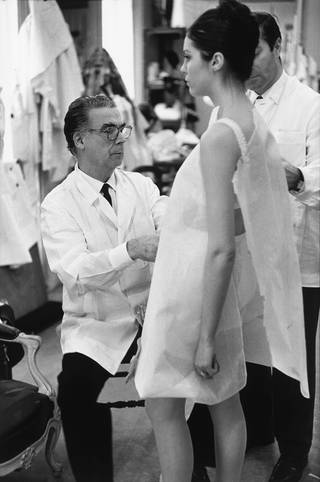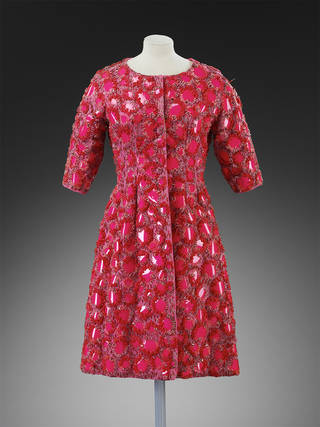Famed for his exquisite craftmanship and innovative designs, Spanish couturier Cristóbal Balenciaga was known as 'The Master' of haute couture. An inspiration to those who follow in his footsteps, his work continues to shape fashion today.
Haute couture is like an orchestra whose conductor is Balenciaga. We other couturiers are the musicians and we follow the direction he gives.
Meet 'The Master'
Born in 1895 in Getaria, a small fishing village in the Basque region of northern Spain, Cristóbal Balenciaga was introduced to fashion by his mother, who was a seamstress. Her clients included the most fashionable and glamorous women in the village. Aged just twelve, he began an apprenticeship at a tailor's in the neighbouring fashionable resort of San Sebastian, where in 1917 he established his first fashion house, named Eisa – a shortening of his mother's maiden name.

Balenciaga opened fashion houses in Barcelona and Madrid before moving to Paris in 1937. The house on Avenue Georges V quickly became the city's most expensive and exclusive couturier. His early training set him apart from other couturiers of the time. He knew his craft inside out and was adept at every stage of the making process, from pattern drafting to cutting, assembling and finishing a garment. For him, the design process started with the fabric rather than with a sketch, "it's the fabric that decides" he stated, proving that he knew how to exploit materials to the very best effect.
Balenciaga alone is a couturier in the truest sense of the word. Only he is capable of cutting material, assembling a creation and sewing it by hand, the others are simply fashion designers.

Balenciaga's Spanish heritage influenced many of his most iconic designs. His wide-hipped 'Infanta' dresses from the late 1930s drew on the portraiture of the 17th-century Spanish artist Diego Velázquez. Flamenco dresses, matador outfits and black lace – seen in the traditional mantilla shawls worn by women at special ceremonies and during Spanish Holy Week – were also frequent motifs.

Shaping fashion
In the 1950s, the later phase of his career, Balenciaga pioneered new shapes never before seen in women's fashion. These radical designs evolved gradually as he refined and reworked the same ideas from season to season. Volume filled the 'balloon hems' of his early 1950s dresses, and was then used at the back of his 'semi-fit' lines in the mid-50s – dresses and jackets fitted at the front but with loose voluminous backs. In 1957 he shocked the fashion world with the introduction of the 'sack dress', a straight up and down shift dress which completely eliminated the waist. At a time when Christian Dior's hour-glass shaped New Look was still dominant, the 'sack' was initially met with hostility from both clients and press. "It's hard to be sexy in a sack!" cried the Daily Mirror. Like many of Balenciaga's most radical designs, this look eventually filtered into the mainstream. The sack dress was the forerunner of the ubiquitous mini-dress of the 1960s – and remains a fashion staple today.

The baby doll dress, also from the late 1950s, continued the theme of abstracting the body, with its trapeze-like shape skimming the waist. This abstraction reached a pinnacle in his designs of the late 60s, as can be seen in the dramatic four-pointed 'envelope dress', shown the year before he closed the house. A sculptural form, moulded from his favourite fabric – stiff but lightweight silk gazar. Although a big hit with the fashion press, only two were sold and one was returned because the client couldn't figure out how to go to the bathroom in it.

Balenciaga dressed some of the most glamorous women of the 1950s and 60s including Hollywood actress Ava Gardener, fashion icon Gloria Guinness and Mona von Bismarck, one of the world's wealthiest women, who commissioned everything from ball-gowns to gardening shorts from the couturier. He liked to dress women who had a strong sense of style and his clients were often extremely loyal. When his fashion house closed in 1968 the news shocked his clinetele who experienced a real sense of loss – Mona von Bismarck supposedly shut herself in her room for three days straight.
Balenciaga's legacy
Unlike some other high-profile designers of the era, Balenciaga was a very private individual. He refused to court the press, giving only one interview during his 50-year career. Despite his allusive nature, Balenciaga led a revolution in fashion, and has consistently been revered by his contemporaries, including the likes of Christian Dior and Coco Chanel, and the fashion leaders of today. French designer Emanuel Ungaro, who trained with Balenciaga, said it was he who "laid the foundations of modernity" in fashion, and both Ungaro and Andre Courrèges, another Balenciaga protégé, took forward their teacher's minimalist aesthetic into the space-age chic of the 1960s.

Cristóbal Balenciaga, the father of Contemporary fashion, is dead, but his influence remains.
The closure of Balenciaga's fashion house in 1968, and his death four years later, marked the end of an era. Yet the master's innovative pattern cutting, use of new materials and bold architectural shapes have remained greatly influential. In 1986 the Balenciaga label re-launched under a series of Creative Directors. Of particular note are Nicolas Ghesquière – widely credited for reviving the label from 1997 to 2012 – and Demna Gvasalia, the current Creative Director who ensures the name Balenciaga is on everybody's lips today. Both designers have worked closely with the Balenciaga House archives, looking to the original designs by The Master for inspiration in cut, shape and materials. As Gvasalia said of his latest collection, which drew heavily on iconic pieces by the house-founder "It is important to know the past in order to build the future".

Balenciaga at the V&A
The V&A holds the largest collection of Balenciaga garments and hats in the UK. Many pieces were sourced for the Museum by society photographer Cecil Beaton, who used his contacts to assemble a prestigious collection of 20th century couture. This filled a significant gap in the Museum's archive, and in 1972 formed the basis of the groundbreaking 1972 exhibition Fashion: an Anthology by Cecil Beaton. Today our Balenciaga pieces are some of the most frequently studied in our Fashion collections, remaining a constant source of inspiration for the next generation of fashion designers.

Find out about our major 2017 exhibition, Balenciaga: Shaping Fashion



